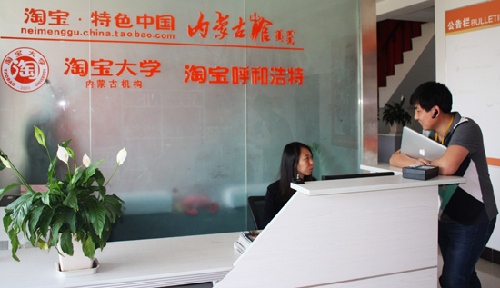E-commerce facilitates agricultural and animal products distribution
(chinadaily.com.cn) Updated: 2014-08-29 13:57Building a pattern of grand warehousing and logistics
Inner Mongolia, unfortunately, has been defined as a frontier and remote area on Alibaba, according to netizens. This definition has led to higher logistics expense.
Liu Xiaojuan, who has been running an online store in Hohhot and mainly sells beef jerky and dairy products, said that he “has to pay an extra 5-8 yuan for logistics because of the classification as a frontier and remote area. Online stores are a low-margin business that depends on sales volume. The current standard for logistics expenses will be a bottleneck for development.”
For Fu Changqing, chairman of 17shop.com, the lack of talent troubles him most. “It may be hard to imagine that our design team is in Beijing, because we can’t find the capable talents here.” As vice-president of the Inner Mongolia E-Commerce Association, Fu has higher expectations in environment for the development of Inner Mongolia’s e-commerce.
Neimenggu.china.taobao.com, an initiative of the Agriculture and Animal Husbandry Bureau of the Inner Mongolia Autonomous Region and Taobao.com (China’s largest online customer-to-customer shopping platform), officially went online on March 11, 2014. It is the ninth provincial pavilion on Taobao, and mainly engages in the selling of Inner Mongolia’s green agricultural and animal products.
 |
|
Neimenggu.china.taobao.com, an initiative of the Agriculture and Animal Husbandry Bureau of the Inner Mongolia Autonomous Region and Taobao.com was officially went online on March 11, 2014.[Photo provided to chinadaily.com.cn] |
Neimenggu.china.taobao.com has over 1,000 merchants selling more than 10,000 goods in over 600 categories at the moment.
According to Jia Yufeng, head of Neimenggu.china.taobao.com, “The asymmetric supply and distribution information, long circulation chain, undiversified products of low added value, as well as high loss rate of transportation of fresh fruits and vegetables are the major problems for the distribution of green agricultural and animal products of the autonomous region at present.”
Currently there is no mature trade platform for supply and distribution of agricultural products in the region, leading to an embarrassing situation where “buyers can’t find sellers while sellers cannot contact buyers,”Jia said.
At present, most agricultural and animal products are circulated through “agents to wholesalers of producing areas to wholesalers of distribution areas to retailers.” A large number of links lead to difficulties in regulation, and food safety problems can be hardly traced back.
Traditional enterprises of green agricultural and animal products suffer from undiversified production lines and product categories, decentralized industrial structure along with the scattered enterprises of many brands and small production scale. As a result, the enterprises and their products have low added-value and weak brand awareness and market competitiveness, according to Jia’s analysis.
Although Inner Mongolia has certain advantages in the quality of rice, flour, grain and oil products, relatively high costs have to be paid for the logistics and distribution of individual products. The high loss rate of transportation of fruits, vegetables, fresh products and immature cold chain logistics cause major bottlenecks for product output from the region.
The distribution of Inner Mongolia’s green agricultural and animal products is a major comprehensive issue, which requires more reasonable planning than just e-commerce.
As the constructor of Neimenggu.china.taobao.com, Lian Mo, chairman of Inner Mongolia Shengluyuan E-Commerce Co, hopes to build an e-commerce public service system that enables direct supply from place of origin, grand warehousing and logistics of all green agricultural and animal products, as well as integrates online and offline channels. Lian also hopes it can provide online wholesale and direct supplies to stores, supermarkets and convenience stores. The core idea of this system is to integrate information and warehousing with logistics, and build a system of enormous scale.
According to Lian’s plan, the “E-Commerce Public Service System for Direct Supply from Places of Origin of Inner Mongolia’s Green Agricultural and Animal Products” consists of platform service, traceability, quality control, channel distribution, and warehousing and logistics systems.
The online platform for direct supply from places of origin has completed construction, testing, decoration and online procedures. Its first batch of products is now online. The product traceability system and product quality control standards are being further improved, and the product testing center is under construction.
In terms of warehousing and logistics services, room temperature storage units have been built in Hohhot and Beijing, while the cold storages are being built in Hohhot and Nanjing.
In order to realize one-stop integrated warehousing and logistics service, Shengluyuan E-Commerce Co is cooperating with EMS in the layout of a national logistics network to develop a one-stop integrated warehousing and logistics service network that is comprehensive and standardized
Inner Mongolia is realizing informatization, grand warehousing and logistics for the distribution of its green agricultural and animal products through e-commerce solutions, and achieving its goal to “purchase from and distribute to the whole country.”
Edited by Michael Thai
- Beijing-Tianjin-Hebei rolls out measures to tackle air pollution
- Prosecutors act to curb child abuse
- Shanghai mulls policies for more talent
- Construction on Nansha Islands 'befits China's intl obligations'
- Safety watchdog sends team to probe fatal fire in nursing home
- 175 grave robbers arrested in biggest-ever tomb raid
- China has no overseas military bases: Spokesperson
- Hero pilots died avoiding built-up area
- Canada to seize assets and extradite fugitives: Envoy
- At least 38 killed in nursing home fire in C China






